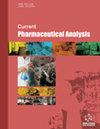An Overview of Biotechnological Drug’s Various Techniques of Downstream Process, Guideline’s And Different Chromatographic Analysis
IF 1.5
4区 医学
Q4 PHARMACOLOGY & PHARMACY
引用次数: 0
Abstract
: Biotechnology, a field discovered in 1919, unites biology and engineering to harness living organisms for medical purposes. Fueled by using DNA's discovery in the 1950s, biotechnology has converted through genetic engineering, yielding impactful merchandise regulated by means of entities like the FDA. The manufacturing involves upstream and downstream processing including the various techniques involved in the downstream processing of biotechnological drugs, along with relevant guidelines and chromatographic analysis methods. The biotechnological industry, which integrates biological science with engineering, has significantly advanced since the discovery of DNA's structure, leading to the development of biopharmaceuticals. These drugs, including monoclonal antibodies, recombinant proteins, and gene therapies, are produced using living organisms and hold the potential for treating complex diseases. The downstream process, a crucial phase in biopharmaceutical production, involves the purification and formulation of drug products to meet stringent regulatory standards. Traditional techniques such as centrifugation, filtration, and chromatography are employed to extract and purify biopharmaceuticals. Chromatographic techniques, including ion exchange, affinity, and size exclusion chromatography, play a pivotal role in achieving the desired purity levels. However, these methods are often time-- consuming and expensive, necessitating continuous advancements in the field. The paper highlights the importance of regulatory guidelines, including cGMP, in ensuring the quality and safety of biopharmaceuticals. It also discusses the significant role of organizations such as the FDA and EMA in regulating biotechnological drug production. The evolution of downstream processing techniques and the development of novel methods promise greater efficiency, scalability, and cost-effectiveness in biopharmaceutical production. Understanding these advancements is essential for continued growth and innovation in the industry, ultimately contributing to improved patient care and pharmaceutical innovation.生物技术药物下游工艺的各种技术、指南和不同色谱分析概述
:生物技术是 1919 年发现的一个领域,它将生物学和工程学结合起来,将生物体用于医疗目的。在 20 世纪 50 年代 DNA 发现的推动下,生物技术通过基因工程进行了转换,产生了受美国食品及药物管理局等实体监管的有影响力的商品。生产涉及上游和下游加工,包括生物技术药物下游加工所涉及的各种技术,以及相关准则和色谱分析方法。生物技术产业是生物科学与工程学的结合,自发现 DNA 结构以来,生物技术产业取得了长足的进步,并由此开发出生物制药。这些药物包括单克隆抗体、重组蛋白和基因疗法,都是利用生物生产的,具有治疗复杂疾病的潜力。下游工艺是生物制药生产的关键阶段,包括药物产品的纯化和配制,以满足严格的监管标准。生物制药的提取和纯化采用离心、过滤和层析等传统技术。色谱技术,包括离子交换色谱、亲和色谱和尺寸排阻色谱,在达到所需的纯度水平方面发挥着关键作用。然而,这些方法往往耗时费钱,因此需要在这一领域不断取得进步。本文强调了包括 cGMP 在内的监管准则在确保生物制药质量和安全方面的重要性。论文还讨论了 FDA 和 EMA 等组织在监管生物技术药物生产方面的重要作用。下游加工技术的发展和新方法的开发有望提高生物制药生产的效率、可扩展性和成本效益。了解这些进步对行业的持续发展和创新至关重要,最终将有助于改善患者护理和医药创新。
本文章由计算机程序翻译,如有差异,请以英文原文为准。
求助全文
约1分钟内获得全文
求助全文
来源期刊
CiteScore
1.50
自引率
0.00%
发文量
85
审稿时长
3 months
期刊介绍:
Aims & Scope
Current Pharmaceutical Analysis publishes expert reviews and original research articles on all the most recent advances in pharmaceutical and biomedical analysis. All aspects of the field are represented including drug analysis, analytical methodology and instrumentation. The journal is essential to all involved in pharmaceutical, biochemical and clinical analysis.

 求助内容:
求助内容: 应助结果提醒方式:
应助结果提醒方式:


